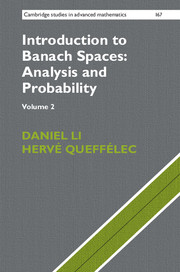Book contents
- Frontmatter
- Dedication
- Contents
- Contents of Volume 1
- Preface
- 1 Euclidean Sections
- 2 Separable Banach Spaces without the Approximation Property
- 3 Gaussian Processes
- 4 Reflexive Subspaces of L1
- 5 The Method of Selectors. Examples of Its Use
- 6 The Pisier Space of Almost Surely Continuous Functions. Applications
- Appendix A News in the Theory of Infinite-Dimensional Banach Spaces in the Past 20 Years
- Appendix B An Update on Some Problems in High-Dimensional Convex Geometry and Related Probabilistic Results
- Appendix C A Few Updates and Pointers
- Appendix D On the Mesh Condition for Sidon Sets
- References
- Notation Index for Volume 2
- Author Index for Volume 2
- Subject Index for Volume 2
- Notation Index for Volume 1
- Author Index for Volume 1
- Subject Index for Volume 1
Preface
Published online by Cambridge University Press: 26 October 2017
- Frontmatter
- Dedication
- Contents
- Contents of Volume 1
- Preface
- 1 Euclidean Sections
- 2 Separable Banach Spaces without the Approximation Property
- 3 Gaussian Processes
- 4 Reflexive Subspaces of L1
- 5 The Method of Selectors. Examples of Its Use
- 6 The Pisier Space of Almost Surely Continuous Functions. Applications
- Appendix A News in the Theory of Infinite-Dimensional Banach Spaces in the Past 20 Years
- Appendix B An Update on Some Problems in High-Dimensional Convex Geometry and Related Probabilistic Results
- Appendix C A Few Updates and Pointers
- Appendix D On the Mesh Condition for Sidon Sets
- References
- Notation Index for Volume 2
- Author Index for Volume 2
- Subject Index for Volume 2
- Notation Index for Volume 1
- Author Index for Volume 1
- Subject Index for Volume 1
Summary
This book is dedicated to the study of Banach spaces.
While this is an introduction, because we trace this study back to its origins, it is indeed a “specialized course”, in the sense that we assume that the reader is familiar with the general notions of Functional Analysis, as taught in late undergraduate or graduate university programs. Essentially, we assume that the reader is familiar with, for example, the first ten chapters of Rudin's book, Real and Complex Analysis (Rudin 2); Queffélec–Zuily would also suffice.
It is also a “specialized course” because the subjects that we have chosen to study are treated in depth.
Moreover, as this is a textbook, we have taken the position to completely prove all the results “from scratch” (i.e. without referring within the proof to a “well-known result” or admitting a difficult auxiliary result), by including proofs of theorems in Analysis, often classical, that are not usually taught in French universities (as, for example, the interpolation theorems and the Marcel Riesz theorem in Chapter 7 of Volume 1, or Rademacher's theorem in Chapter 1 of Volume 2). The exceptions are a few results at the end of the chapters, which should be considered as complementary, and are not used in what follows.
We have also included a relatively lengthy first chapter introducing the fundamental notions of Probability.
As we have chosen to illustrate our subject with applications to “thin sets” coming from Harmonic Analysis, we have also included in Volume 1 an Annex devoted to compact Abelian groups.
This makes for quite a thick book, but we hope that it can therefore be used without the reader having to constantly consult other texts.
We have emphasized the aspects linked to Analysis and Probability; in particular, we have not addressed the geometric aspects at all; for these we refer, for example, to the classic Day, to Beauzamy or to more specialized books such as BENYAMINI–LINDENSTRAUSS, DEVILLE–GODEFROY–ZIZLER or PISIER 2.
- Type
- Chapter
- Information
- Introduction to Banach Spaces: Analysis and Probability , pp. xiii - xxxPublisher: Cambridge University PressPrint publication year: 2017



